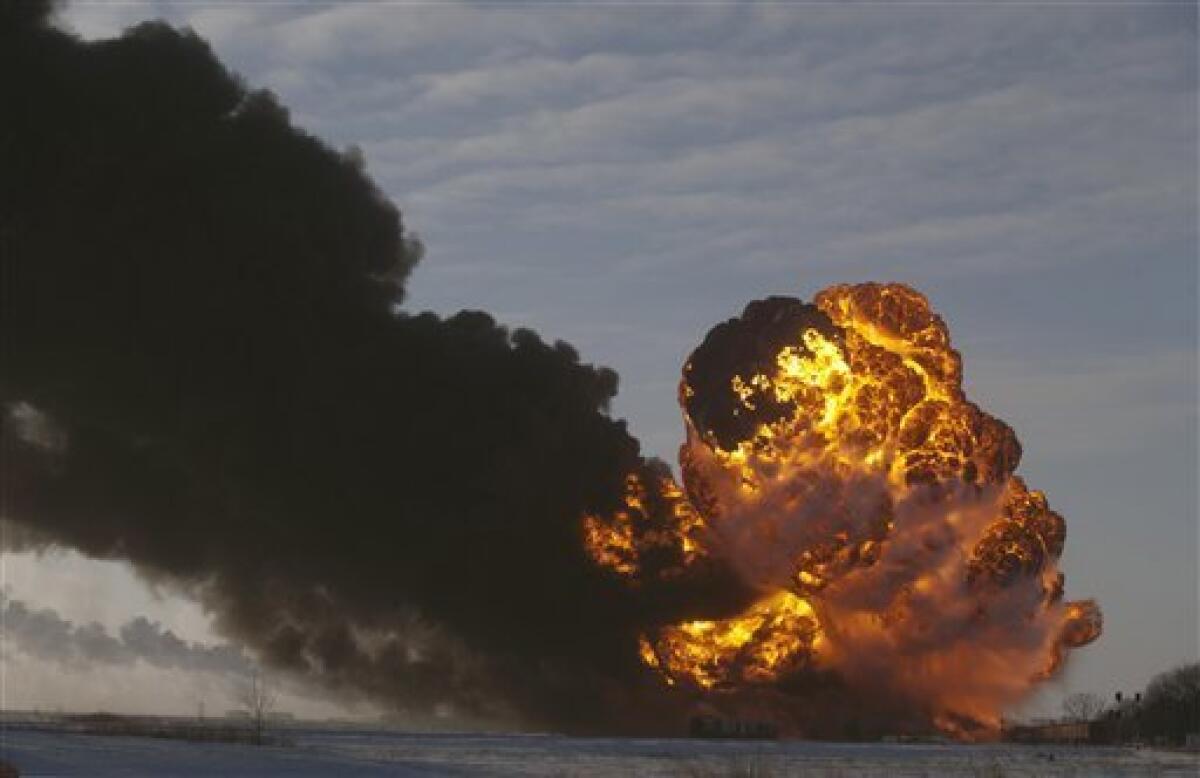Crude oil train accidents prompt NTSB safety recommendations

- Share via
After four major crashes involving North American trains transporting crude oil, the National Transportation Safety Board on Thursday issued three recommendations intended to protect the public in the event of future derailments, fires and spills.
The NTSB moved quickly to issue the recommendations after opening an investigation into a massive explosion outside Casselton, N.D., last month that resulted from the crash of a BNSF Railway crude train into another train. The investigation, which is the first comprehensive study of increased movements of oil on rail, remains open.
But the NTSB cited the massive increase in crude shipments and the resulting public risks in explaining the early recommendations, saying it “is concerned that major loss of life, property damage and environmental consequences can occur when large volumes of crude oil or other flammable liquids are transported on a single train involved in an accident.”
The frequency of such rail accidents appears to be growing. Just this week, a CSX freight train carrying crude oil derailed on a railroad bridge in Philadelphia, forcing the closure of the busy Schuylkill Expressway, authorities said. The derailment, which did not result in a spill or fire, followed more serious ones in North Dakota, Alberta, Alabama -- and in Quebec, where a catastrophic crash and explosion devastated the town of Lac-Megantic and killed 47 people.
“The large-scale shipment of crude oil by rail simply didn’t exist 10 years ago, and our safety regulations need to catch up with this new reality,” NTSB Chairman Deborah A.P. Hersman said. “While this energy boom is good for business, the people and the environment along rail corridors must be protected from harm.”
The 15 pages of recommendations were issued jointly with Canadian authorities. The most significant one calls for “expanded hazard material route planning for railroads” so that trains avoid populated areas and other sensitive regions.
The NTSB lays a legal and regulatory framework for stricter route planning that notes federal rules already require trains carrying poisons and other toxins to avoid populated areas.
The NTSB said current rules and regulations do not extend that route planning to trains carrying flammable crude but notes that the accident last summer in Lac-Megantic shows that such trains pose significant risks. As a result, the NTSB said the Federal Railroad Administration and the Pipeline and Hazardous Materials Safety Administration should extend existing rules applying to toxic materials to trains carrying crude.
In addition, the NTSB recommended that the hazardous materials agency improve tank car safety standards to make the cars more puncture resistant. After the Quebec accident, the agency began a long rule-making process to update tank car standards, but rule-making can often take years.
In its third recommendation, the NTSB called for audits of shippers and rail carriers to “ensure” that they properly classify the flammability of crude and have adequate response capabilities for the worst-case accidents. It noted that the Lac-Megantic incident spilled 1.6 million gallons of crude oil.
“The Lac-Mégantic accident shows that railroad accidents involving crude oil have a potential for disastrous consequences and environmental contamination equal to that of the worst on-shore pipeline accidents,” the NTSB said.
The existing rules on responses circumvent “the need for railroads to comply with spill response planning mandates of the federal Clean Water Act,” the NTSB said.
The railroad industry endorsed the recommendations.
The Assn. of American Railroads said in a statement that it “is in full agreement with the safety boards’ recommendations today, as they align with our previous calls for increased federal tank car safety standards as well as the work the industry is undertaking with our customers and the administration in an environment of shared responsibility for the safe movement of America’s energy products. Through these efforts and more, railroads are doing all they can to make a safe rail network even safer.”
In a separate statement, the association noted that rail and energy sector leaders met last week with Transportation Secretary Antony Foxx to discuss actions to improve the safety of crude-oil trains.
ALSO:
Justin Bieber charges: DUI, resisting arrest; admits smoking pot
Biggest storm surge in decades delivers monster waves to Hawaii
Alleged mobster arrested in Lufthansa heist that inspired ‘Goodfellas’
More to Read
Sign up for Essential California
The most important California stories and recommendations in your inbox every morning.
You may occasionally receive promotional content from the Los Angeles Times.











